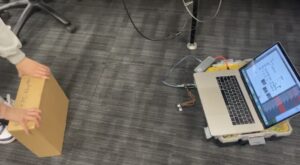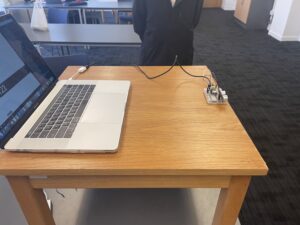22/03/2023
ECA
Xiaoqing Xu, Chenyu Li , Allison Mu
Initial Connection with Arduino under MAX Threshold Function Structure
23/03/2023
Allison House
Xiaoqing Xu, Chenyu Li, Allison Mu
Connection to distance sensing under Arduino architecture with trigger test by observer
Comparing the advantages and disadvantages of distance sensor and photosensitive sensor


24/03/2023
Teams
David, Xiaoqing Xu
Attempt to connect the modified Max patch with the full Arduino architecture

28/03/2023
Allison House
David, Xiaoqing Xu, Chenyu Li, Allison Mu
Observer step test and trigger threshold adjustment
Tuning modification of interactive trigger sound

Initially, the threshold values were set in units of 10, but during testing, it was observed that the change in distance values was not sufficient to trigger all the auditory information of the sound, including the instantaneous audio content. Therefore, the threshold values were simplified based on the step distances of multiple people to achieve the most ideal trigger effect. This involves adjusting the threshold values to accurately detect when someone is stepping onto or off the stairs, and ensuring that the corresponding sound is triggered in a timely and accurate manner.
During the initial design phase, our team considered three types of sensors: pressure, distance, and photosensitive sensors. However, we found that the pressure sensor did not provide accurate data that reflected the simulated climbing state. The photosensitive sensor was also problematic due to its sensitivity fluctuations, which were influenced by the surrounding environment and made it difficult to isolate variables. After conducting tests and comparisons, we determined that the distance sensor was the most sensitive and best suited for detecting the observer’s movement in the test state. However, during our actual tests, we discovered that the clothing material worn by the observer could absorb reflections and cause errors in the data readings. To overcome this issue, we identified that a smooth plane with a certain area could more quickly and sensitively respond to real-time sensing data from the distance sensor.
All the sound samples Playlist was initially classified according to the sound body, but in the process of actual testing all the triggered sounds were slightly mixed in the hearing, and it was difficult to distinguish their triggering time points, so our sound team divided them further, that is, the four action states were actually simulated from the perspective of trasient and sustain, and all the sound Playlists were classified and divided again, and all the sound Playlists were set up with transition processing between two and two to make the triggering more natural and realistic.

